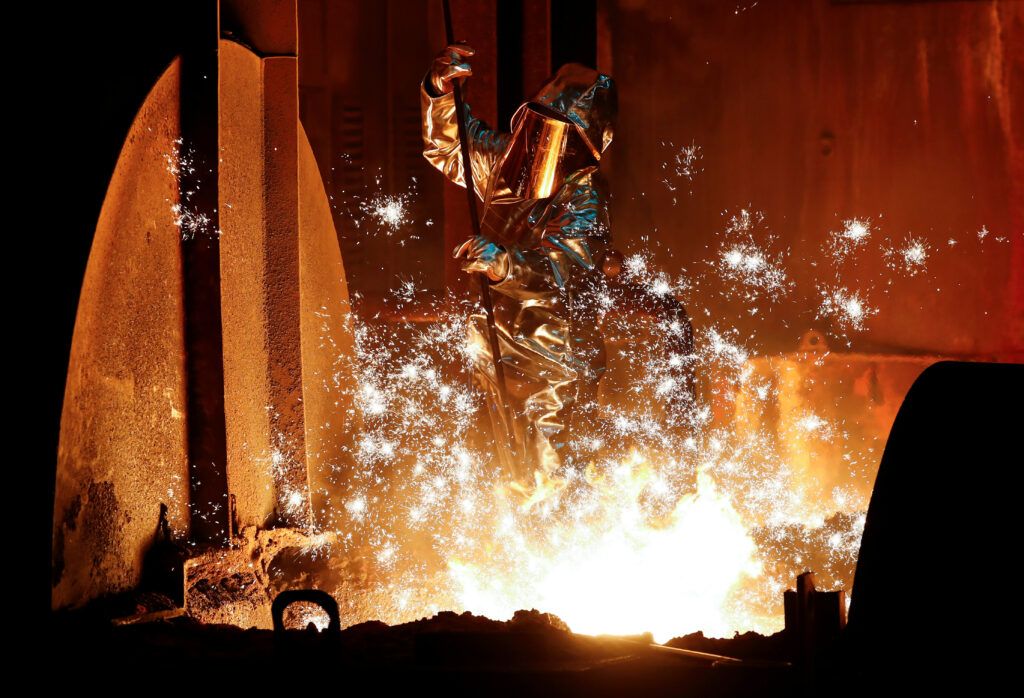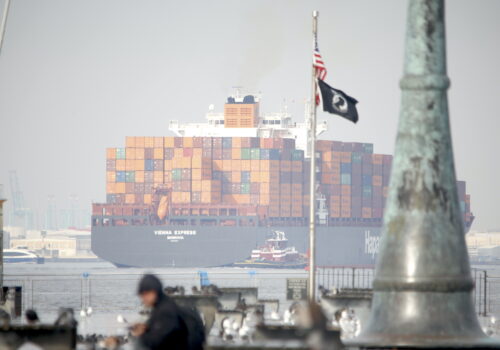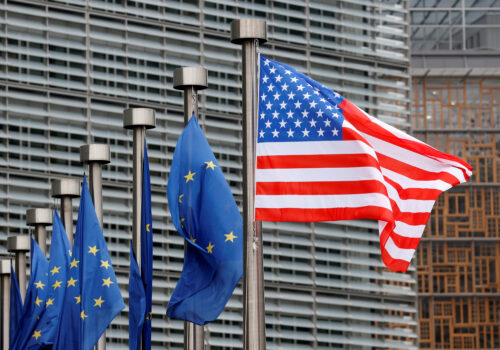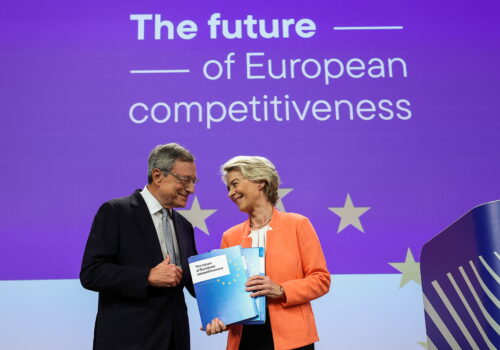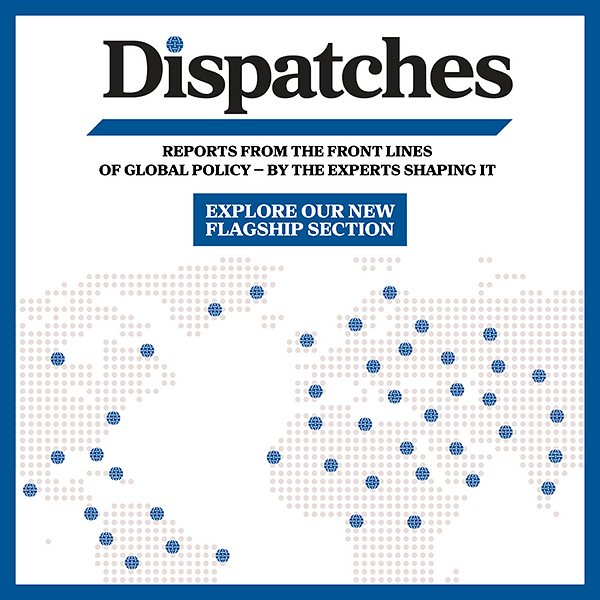US President Donald Trump marked Super Bowl weekend with an in-flight announcement, followed by an executive order on Monday setting a 25 percent tariff on all steel and aluminum imports entering the United States. The first round of tariffs reserved for the United States’ top trading partners—Canada and Mexico (both got a thirty-day pause in extremis), and China (which now faces a blanket 10 percent tariff in addition to preexisting tariffs)—spared the European Union (EU). But it was only a matter of time until “America first” trade policy darkened the doorway of the Berlaymont. Now facing both a steel and aluminum tariff set to take effect in mid-March and “reciprocal” tariffs as soon as April, Brussels is poised to reveal its response. Game on.
For transatlantic trade watchers, US tariffs on steel and aluminum imports provoke a sense of déjà vu. During Trump’s first administration, Washington and Brussels clashed over a 25 percent tariff on steel and a 10 percent tariff on aluminum, impacting 6.4 billion euros worth of European exports. Brussels responded with levies until then European Commission President Jean-Claude Juncker brokered a (sort-of) deal, promising increased purchases of US liquefied natural gas (LNG) and soybeans. During the Biden administration, Trump’s tariffs were suspended for two years, with the aim of negotiating a Global Arrangement on Sustainable Steel and Aluminum (GASSA), which would permanently replace the tariffs. Despite championing transatlantic relations, negotiation efforts on GASSA at the promising US-EU Trade and Technology Council sputtered, leaving the dispute unsolved and only temporarily suspending the tariffs until March 2025.
The incoming tariff on aluminum and steel would hurt Europe. It threatens the EU’s $3.1 billion worth of metal exports across the Atlantic. Particularly exposed are Europe’s major economies—Germany and Italy—as they are the sixth- and tenth-largest US suppliers of steel and aluminum, doing $4.5 billion and $2.7 billion in trade in 2023, respectively. Berlin and Rome exchange higher-end steel and aluminum, segments where demand tends to be less sensitive to price fluctuations and tariffs. With the White House granting no “exemptions” to partners and scrapping previous metal quota agreements, alongside the impending reciprocal tariff, European Commission President Ursula von der Leyen has vowed “firm and proportionate countermeasures.” The stage is set for Europe’s response.
Deep breaths
With the tariff deadline set for March 12, Brussels will first leverage this pivotal time window to seek a negotiated solution to avoid a “lose-lose” scenario with its largest trading partner. To safeguard the commercial relationship, accounting for $1.55 trillion in goods and services exchanged, Brussels has a few options to propose (albeit not without complications):
- Decrease its 10 percent import taxes on US vehicles (thereby further exposing the EU market to Chinese-made cars),
- Purchase more US LNG and agricultural products (although capacity constraints exist), and
- Buy more US-made defense equipment.
The EU could also get more creative. Further commitments could include toughening energy sanctions on Russia and aligning with the United States on a tougher China policy. While unlikely, the European Commission could also explore the idea of mandating EU member states to reduce their trade surpluses through increased domestic demand.
Punch back
Should negotiation attempts fail, the EU will likely respond with retaliatory tariffs. A first move could be the reinstatement of suspended tariffs on US steel and aluminum, and target notable US exports to Europe, such as Levi’s jeans, Harley Davidson motorcycles, bourbon whiskey, cosmetics, cranberry juice, orange juice, peanut butter, and other agricultural products. Europe could also take a page from Canada and apply targeted tariffs on Tesla or Starlink, companies owned by Trump’s billionaire adviser Elon Musk. Back in 2018, Brussels hit 2.8 billion euros worth of US exports and held additional levies worth 3.6 billion euros ready to fire. This time, the proposed retaliation would amount to 4.8 billion euros’ worth of US goods. Additional ways to ramp up pressure on Washington might include tightening technical barriers to trade or restricting US companies from European public procurement tenders through its International Procurement Instrument.
Unveil the ACI
In parallel, by labeling the proposed US tariffs as “unlawful,” the European Commission laid the foundation to deploy, for the first time, its anti-coercion instrument (ACI). This legal framework enables the EU to retaliate against third countries that are “coercing” the European Union, a member state, or a European industry.
Established in December 2023, this new trade defense instrument fits within the EU’s open strategic autonomy strategy. The instrument draws lessons from both Trump’s first-term trade spat and China’s embargo on Lithuanian imports over Vilnius’s Taiwan policy in 2021.
While the primary objective of ACI remains deterrence, the instrument represents the toughest World Trade Organization–compatible tool at the EU’s disposal. The set of countermeasures include imposing higher customs duties and export controls, restricting or suspending intellectual property rights, banning services or applying duties to digital platforms such as streaming services, and enforcing investment restrictions and limits on foreign direct investment. Moreover, the ACI also enables the EU to engage and limit third-country access to public procurement tenders, restrict financial services companies’ access to EU markets, and curb the entry and use of US chemicals, sanitary products, and agricultural goods.
Speed and unity
Despite being dubbed the “bazooka” among Brussels’ trade policy wonks, the ACI faces two hurdles—speed and unity. First, to trigger the defense mechanism according to the letter of the law, the European Commission must conduct an “examination,” reach a “determination,” and engage in “consultations”—Brussels-speak for a drawn-out process expected to last between three to six months. Second, a qualified majority is needed to approve ACI countermeasures, requiring consensus from at least fifteen of the twenty-seven member states, representing 65 percent of the EU’s population—a high threshold in an often-fractious bloc. The EU’s deliberative process would likely run up against Trump’s often hasty decision making and his preference to deal bilaterally with countries, thus making the ACI difficult to utilize effectively.
However, encouraging signals are coming from European capitals. German Chancellor Olaf Scholz underscored the bloc’s preparedness “to act within an hour” if forced to, a sentiment echoed by French Industry Minister Marc Ferracci’s call for Europe to “respond in a united and firm manner.” Even traditionally tariff-averse countries in Northern and Central European—the Netherlands, Poland, and the Baltic states—have expressed support for a coordinated European response.
A transatlantic trade war would hurt both sides and do potentially irreparable harm to the transatlantic political and economic relationship at a time when the United States and Europe need each other more than ever. Europe especially is in a tough spot. Amid sluggish economic growth prospects, a wide trade surplus in goods vis-à-vis the United States, and Russia’s ongoing war in Ukraine, Europe’s priority should be to de-escalate tensions and rapidly mitigate the potential impacts of US tariffs. At the same time, Brussels cannot shy from difficult trade negotiations with Washington, doing “whatever is necessary” with the “same tools and weapons if need be,” as France’s minister of economy and finance warned on February 10.
A trade spat and the subsequent negotiations will be an early test for how the European Commission will navigate the geopolitical ambitions envisioned by von der Leyen since her first term. This latest chapter in US–EU trade will test Europe’s resilience and statecraft, as well as its ability to achieve its long-time ambition of “strategic autonomy” and reignite the eurozone’s global competitiveness. With the first official meetings between the US government and EU officials are underway in Paris and set to continue during the the Munich Security Conference over the weekend, these early negotiations will set the tone for transatlantic trade relations over the next four years.
Jacopo Pastorelli is a program assistant in the Atlantic Council’s Europe Center.
Further reading
Tue, Feb 4, 2025
Where do the Trump tariffs go from here?
Fast Thinking By
US tariffs on China went into effect today, while President Donald Trump paused levies on Mexico and Canada. Our experts explain who and what could be next.
Sun, Jan 19, 2025
On trade and technology, the US and EU need each other now more than ever
New Atlanticist By
Washington and Brussels must collaborate on telecommunications, semiconductors, and critical minerals to compete with nonmarket economies.
Mon, Jan 6, 2025
The Draghi report grabbed Europe’s attention. Now it’s time for the EU to put it into action.
New Atlanticist By
Enhancing the European Union’s competitiveness is compatible with strengthening its economic relations with the United States.
Image: A steel worker of Germany's industrial conglomerate ThyssenKrupp AG which holds its annual shareholders meeting on Friday February 1, 2019, takes a sample of raw iron from a blast furnace at Germany's largest steel factory in Duisburg, Germany, January 28, 2019. Picture taken January, 28, 2019. REUTERS/Wolfgang Rattay.
